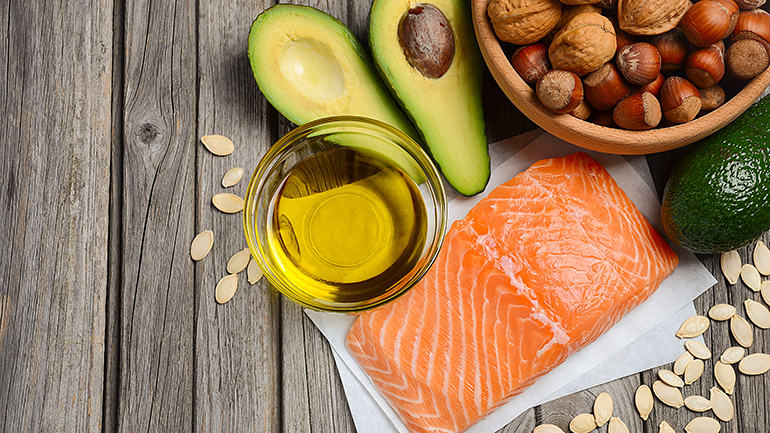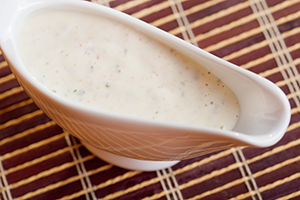
Eating more fat in food: a fad? Our dietitian serves up facts on fats.
Are you feeling a little lost or unsure about fat these days? You’re not alone.
Not long ago, fat got a bad rap, and low-fat or fat-free eating was considered healthy. Recently, there has been more attention to the value of fats in food, and high-fat foods are gaining in popularity. With so much conflicting attention on the subject, many of us are wondering: Are fats good for you? And which is the right fat to choose?
The benefits of fat
Fats are essential. We need to eat them to stay healthy. Fat is a source of energy and plays an important role in vitamin absorption and brain and nerve function. It also nourishes healthy skin, and by slowing digestion helps us feel more satisfied from our meals. Research has shown that when following a no-fat or low-fat diet, we often increase our carbohydrate intake. If our carbohydrate choices are lacking fibre, such as refined flours and sugary cereals, we can actually increase our risk of Type 2 diabetes and heart disease.
The facts on fat
There are three types of fat in food: saturated fat, unsaturated fat and trans fat. The concerns around fat relate to its association to heart disease. Let me clear things up for you.
Saturated Fat: Solid at room temperature, found in animal food sources (butter, lard, visible fat on meat, processed meats/sausages/bacon, shortening) as well as coconut and palm oils.
FAT FACT: Scientific evidence supports the replacement of saturated fat in the diet with unsaturated fats for cardiovascular risk reduction. Dairy products also contain saturated fat but are considered healthy, as they offer cardiovascular protection.
Trans Fat: Dominant sources are man-made by partial hydrogenation (taking a liquid oil and turning into a semi-solid fat) and used in many snack foods, baked goods, pastries, hard margarines and some deep-fried foods.
FAT FACT: Research has consistently shown a link between the intake of trans fats and increased risk of heart disease.
Unsaturated Fat: Liquid at room temperature, sources of antioxidants and anti-inflammatory compounds, and linked to heart health benefits. Sources include olive oil, sunflower oil, canola oil, nuts, seeds, avocado and fatty fish.
FAT FACT: Mediterranean eating patterns rich in unsaturated fat from olive oil, nuts, seeds and fish offer significant cardiovascular benefits.
Eating to include healthy fats
- Forget low-fat or no-fat diets. The latest guidelines indicate adults should include two to four tablespoons of added fat per day, primarily from unsaturated sources.
- Cholesterol in food is no longer the focus when eating a heart healthy diet which means eggs aren’t bad – enjoy them as a source of protein in a balanced diet.
- Avoid trans fats by reading labels and reducing use of packaged and processed foods.
- Reduce saturated fat by choosing leaner cuts of meat and replacing saturated fat with unsaturated fats (e.g. natural peanut butter on toast instead of butter, grapeseed or avocado oil in baking instead of coconut oil, olive oil salad dressing). Try the olive-oil Caesar salad dressing recipe below for a better alternative to store-bought dressings.
- Include more foods with unsaturated fat in your diet, such as a quarter cup of nuts per day, or Omega-3 rich fatty fish twice a week (e.g. salmon, trout, mackerel and sardines) or vegetarian sources such as ground flax, chia seeds, hemp seeds and walnuts.
- Dairy products are rich in many nutrients and have heart health benefits, so enjoy a little fat from yogurt, cheese and milk as a part of balanced meals or snacks.
- Fats are healthy but do come with more than double the calories of protein and carbohydrates per gram, so be mindful of portions and how much fat you add to food.
Now that you’ve got the latest fat facts, it’s time to stop considering this food source a foe. To learn more about how to incorporate healthy fats into your diet refer to this Health Canada fat fact sheet. If there are other food fads that are making your mealtime stressful, check out this Dietitians of Canada fact sheet on separating food facts from food fads.
Homemade Ceasar salad dressing
adapted from Rebar Modern Food Cookbook
1 tbsp capers
1 tbsp caper juice
Juice of 1 lemon
2-3 tsp Dijon mustard
2 cloves garlic minced
1/3 cup grated Parmesan cheese
1 cup olive oil
Pepper to taste
Place all ingredients in blender and blend at high speed until smooth. Pour over kale and add roasted chickpeas for a crouton like crunch for a new take on the old Caesar salad. Store extra dressing in a jar in the fridge, if it thickens just bring back to room temperature to thin or use as a dip with veggies.

